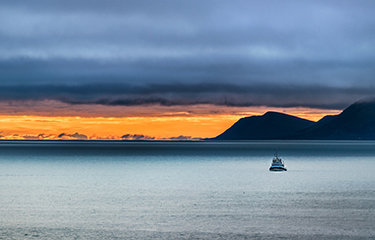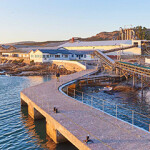Bering Sea tanner crab season ends as Alaĝum Kanuux̂ marine sanctuary debated

Two million pounds of tanner crab was caught in the Bering Sea fishery this fall and winter season, fulfilling a record low quota that is only partially meeting demand for Alaska king crab and snow crab that is off-limits this year.
The 17 vessels in the east and west districts of the fishery in the largest U.S. state caught the full quota by the end of March, according to Ethan Nichols, the Alaska Department of Fish and Game’s assistant area management biologist for the area. Additionally, one vessel fishing the Eastern Aleutian tanner crab fishery off Unalaska Island caught around 49,000 pounds of crab. Nichols said the health of the fishery is strong, with a 2022 survey showing the area’s tanner crab population doubled year-over-year, reaching its highest level since 2005.
“Overall, the fishery performance was pretty good,” Nichols told KUCB. “Vessels were targeting and retaining crabs that were smaller than the industry-preferred size of five inches, but still perfectly legal to retain, and that was somewhat to make up for the lack of snow crab coming out of the Bering Sea.”
Nichols said some buyers were accepting smaller crab they might not have purchased in prior seasons to make up for a hole in supply caused by the closure of other crab fisheries in the Bering Sea. The federal government has made disaster declarations to cover the canceled Bering Sea snow crab and Bristol Bay red crab harvests, as well as the closure of the king crab fishery in Norton Sound in 2020 and 2021. Bering Sea snow crab, also known as opilio crab, has been declared by NOAA to be overfished.
Another survey is scheduled to take place this summer to get an updated estimate of the health of Bering Sea crab populations, Nichols said.
In the meantime, an effort to create a marine sanctuary in the Bering Sea near the Pribilof Islands is hitting pushback from the commercial fishing industry.
The Unangax (Aleut) community of St. Paul Island has proposed the creation Alaĝum Kanuux̂ marine sanctuary, with co-management between it, the community of nearby St. George Island, and the U.S. government. The sanctuary would encompass nearly 53,000 square miles of waters, excluding a quarter-mile buffer zone around the St. George and St. Paul harbors and all shoreside and submerged industrial facilities on both islands. The National Oceanic and Atmospheric Administration (NOAA) accepted the nomination in June 2022.
Lauren Divine, the director of the tribe’s ecosystem conservation office, said her community believes the sanctuary would increase tourism, pull in research dollars, and give it greater agency to manage local subsistence and commercial fisheries, which are currently managed by NOAA and the state of Alaska.
“That co-management aspect is really important because it's a step towards self-determination, sovereignty,” Divine told KUCB. “It really speaks to going back to Indigenous stewardship of lands and waters, which have operated successfully and sustainably since time immemorial.”
But commercial fishing interests have lined up in opposition to the proposal, arguing the co-management proposal threatens their ...
Photo courtesy Ruben M. Ramos/Shutterstock




Share